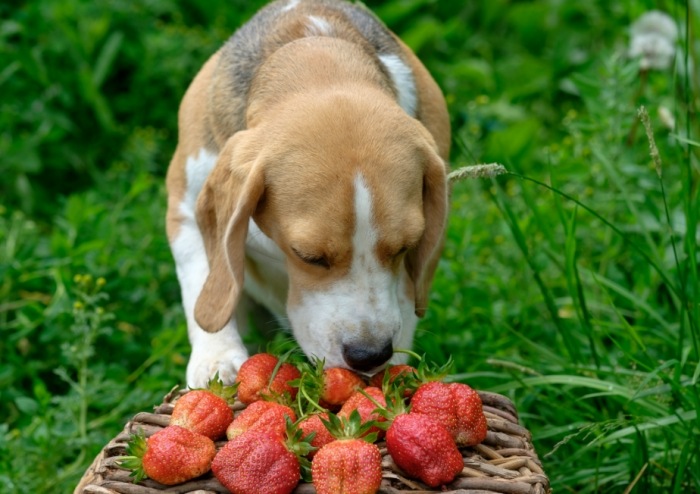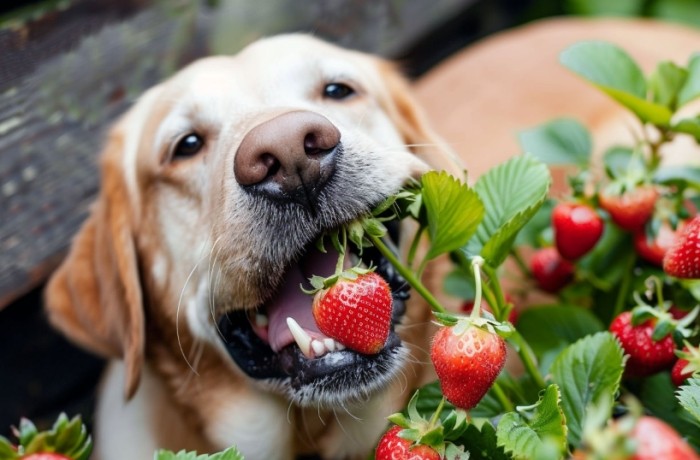Advertisements
Can Dogs Have Strawberries? Benefits, Safety, Feeding Tips & What to Do If They Eat Too Many
Hi, I'm Riley! As a Canadian pet owner who shares my home with both cats and dogs, I've often been asked about feeding human foods to pets. One question that comes up frequently is whether dogs can safely enjoy strawberries - those sweet, juicy red berries that are so plentiful during our short Canadian summers.
Whether you're wondering if you can share a berry with your begging pup or concerned after your dog got into the strawberry patch, this guide will give you evidence-based advice to keep your furry friend happy and healthy.
Table of Contents
Can Dogs Have Strawberries?
First things first, let's tackle the big question: can dogs have strawberries? The short answer is yes! Dogs can indeed have strawberries. But before you start tossing handfuls of these red fruits to your pup, let's explore a bit more.
The Basics of Strawberries and Dogs
Strawberries are a delicious and nutritious fruit that humans enjoy. They're packed with vitamins, antioxidants, and fiber. But when it comes to our four-legged friends, we need to be a bit more cautious. While strawberries aren't toxic to dogs, not all parts of the strawberry are created equal when it comes to canine consumption.
Potential Benefits
- Vitamin C Boost: As mentioned, strawberries are a great source of vitamin C, which helps keep your dog's immune system strong.
- Fiber for Digestion: The fiber in strawberries can help regulate your dog's digestive system and prevent constipation.
- Low in Calories: If your dog is on a diet or needs to watch their weight, strawberries can be a great low-calorie treat.
Risks to Consider
- Sugar Content: Strawberries do contain natural sugars, which can be a problem if your dog is diabetic or prone to weight gain.
- Choking Hazard: Small pieces of strawberry can pose a choking hazard, especially for smaller dogs. Always cut them into bite-sized pieces.
- Allergic Reactions: Just like humans, dogs can have allergic reactions to certain foods, including strawberries. Watch for any signs of itching, swelling, or difficulty breathing after your dog eats strawberries.

Are Strawberries Good for Dogs?
Now that we've established that dogs can have strawberries, let's dive deeper into whether they're actually good for them. As mentioned earlier, strawberries offer several nutritional benefits that can be beneficial for your dog's health. But it's important to remember that not all dogs will react the same way to strawberries.
Individual Differences
Every dog is unique, and what works for one might not work for another. Some dogs might love strawberries and tolerate them well, while others might have an upset stomach or show signs of an allergic reaction. It's always a good idea to introduce new foods slowly and in small quantities to see how your dog reacts.
Moderation is Key
Even if your dog loves strawberries and seems to tolerate them well, it's crucial to practice moderation. Too many strawberries can lead to digestive issues like diarrhea or vomiting. Stick to giving your dog a few pieces as a treat rather than making them a regular part of their diet.
Consulting Your Vet
If you're unsure about whether strawberries are a good fit for your dog, it's always a good idea to consult your vet. They can provide personalized advice based on your dog's age, breed, health history, and dietary needs.
Is Strawberry Toxic for Dogs?
Okay, so we know that dogs can have strawberries and that they can offer some nutritional benefits. But is strawberry toxic for dogs? The answer is generally no, but there are some caveats.
Non-Toxic but Potentially Harmful
While strawberries themselves aren't toxic to dogs, certain parts of the strawberry or certain preparations of strawberries can be harmful. For example, the leaves and stems of strawberries contain small amounts of cyanide, which can be toxic in large quantities. However, the amount found in the leaves and stems of a few strawberries is unlikely to cause harm to your dog. Still, it's best to remove the leaves and stems before giving strawberries to your pup.
Processed Strawberry Products
Another thing to watch out for is processed strawberry products like strawberry yogurt, strawberry jelly, or strawberry-flavored treats. These often contain added sugars, artificial flavors, and other ingredients that can be harmful to dogs. Always check the ingredient list and avoid giving your dog anything with added sugars or artificial additives.
Signs of Toxicity
If your dog does manage to get into a large quantity of strawberries or ingests something with added sugars or artificial ingredients, watch for signs of toxicity like vomiting, diarrhea, lethargy, or difficulty breathing. If you notice any of these symptoms, contact your vet immediately.
How Much Strawberry Can I Give My Dog?
Now that we've covered the safety aspects of giving strawberries to your dog, let's talk about quantity. How much strawberry can I give my dog? Well, it depends on your dog's size, age, and overall health.
Size Matters
A general rule of thumb is to give your dog no more than a few small pieces of strawberry at a time. For smaller dogs, this might mean just one or two pieces, while larger dogs can handle a few more. Always start with a small amount and see how your dog reacts before giving them more.
Age and Health Considerations
Puppies and senior dogs might have more sensitive digestive systems, so it's best to give them even smaller amounts of strawberry or avoid it altogether if they have a history of digestive issues. Dogs with diabetes or other health conditions might also need to limit their strawberry intake due to the sugar content.
Treats vs. Regular Food
Remember, strawberries should be given as a treat, not as a regular part of your dog's diet. They should make up no more than 10% of your dog's daily caloric intake. If you're unsure about how much to give your dog, consult your vet for personalized advice.
How to Safely Feed Strawberries to Dogs
Alright, so you've decided to give your dog some strawberries. Great! But how do you do it safely? Here are some tips on how to safely feed strawberries to dogs.
Preparation Tips
- Wash Thoroughly: Always wash strawberries before giving them to your dog to remove any pesticides or dirt.
- Remove Leaves and Stems: As mentioned earlier, the leaves and stems of strawberries contain small amounts of cyanide, so it's best to remove them.
- Cut into Bite-Sized Pieces: To prevent choking, always cut strawberries into small, bite-sized pieces.
Serving Suggestions
- Fresh Strawberries: The simplest and healthiest way to give your dog strawberries is fresh and raw. Just wash, cut, and serve!
- Frozen Strawberries: If your dog enjoys cold treats, you can freeze strawberries and give them as a refreshing summer snack.
- Mashed or Pureed: For older dogs or dogs with dental issues, you can mash or puree strawberries and mix them into their regular food.
Avoiding Pitfalls
- No Added Sugars: Always avoid giving your dog strawberries with added sugars, syrups, or other sweeteners.
- No Artificial Flavors: Stay away from strawberry-flavored treats or products that contain artificial flavors or colors.
- Monitor Your Dog: Always keep an eye on your dog when they're eating strawberries to make sure they're not having any adverse reactions.

My Dog Ate Too Many Strawberries – What Should I Do?
Oh no! Your dog got into the strawberry basket and ate way more than they should have. What should you do now? Don't panic, here's what you need to know.
Signs of Overindulgence
If your dog ate too many strawberries, they might experience digestive issues like vomiting, diarrhea, or abdominal pain. They might also seem lethargic or have a decreased appetite.
Immediate Steps
- Monitor Your Dog: Keep a close eye on your dog for any signs of distress or discomfort.
- Offer Water: Make sure your dog has access to plenty of fresh water to stay hydrated.
- Contact Your Vet: If your dog is showing severe symptoms or if you're unsure about what to do, contact your vet immediately.
Long-Term Considerations
- Adjust Diet: In the future, make sure to store strawberries and other human foods out of your dog's reach.
- Practice Moderation: Stick to giving your dog small amounts of strawberries as a treat to prevent overindulgence.
- Know Your Dog's Limits: Every dog is different, so pay attention to how your dog reacts to different foods and adjust accordingly.

Q&A Section
Alright, let's tackle some common questions about dogs and strawberries.
Can Dogs Eat Strawberry Tops?
As mentioned earlier, the leaves and stems of strawberries contain small amounts of cyanide. While the amount found in a few strawberry tops is unlikely to cause harm to your dog, it's best to remove them to avoid any potential risks.
Can Dogs Have Strawberry Yogurt?
While strawberry yogurt might seem like a tasty treat for your dog, it often contains added sugars and artificial flavors that can be harmful. Stick to giving your dog plain, unsweetened yogurt in small amounts as a treat, or better yet, just give them fresh strawberries.
Can Dogs Have Strawberry Jelly?
No, dogs should not have strawberry jelly. Jelly often contains high amounts of sugar, artificial flavors, and other ingredients that can be harmful to dogs. Stick to giving your dog fresh strawberries or other dog-friendly treats.
What Fruits Are Not Good for Dogs?
While many fruits are safe for dogs in moderation, there are some that should be avoided altogether. These include grapes and raisins, which can cause kidney failure in dogs; avocados, which contain persin, a toxin that can be harmful to dogs; and cherries, which contain cyanide in their pits. Always do your research before giving your dog any new fruits or vegetables.
Leave a Message